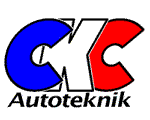

|
|
|
| |
Evolution of the spare parts numbers |
In itself, a spare part number, is just a reference of letters and numbers that do not seem to have special significance. This is also the case for some Citroën parts, but in most cases, it is possible to derive a lot of information from the numbers themselves and from the various codes that often surround the numbers in catalogues, price lists, on labels and other places. It is the intention of this article, to give an overview of the many series of spare parts number systems, used by Citroën over time, and to provide some degree of understanding of the systems and codes, Citroën has used in connection with the spare parts numbers.
|
When Citroën began car production in 1919, the spare parts were assigned
numbers beginning with 1 and more or less continuing sequentially.
From the large, complete
spare parts catalogue from 1919-28,
you get the impression that the various models are just different versions
of the same essential thing: The Citroën Automobile!
It seems that numbers have been assigned in smaller series of the same family
of parts (a series of wings, a series of front arms etc), but with no regard
to what particular model a part belongs. These series, in turn, appear to
have been assigned in no particular order. At the end of each of these series,
there are usually unused numbers that could be used to assign numbers to new
parts of the particular type.
The only main rule is that the lower the number, the older the part is, relative to parts of the same family. Already in the 1920s, the numbers exceed 100.000, and when we reach the war, a lot of the numbers below 100.000 had gone out of use since they belonged to discontinued models, and those which were still in use, were therefore to a large extent parts of a generic character, like nuts, bolts, bushes, washers, bearings etc. Parts that were initially considered to be generic standard parts were given a suffix -S. These numbers have probably been assigned along with the others, rendering them unique, even without the -S suffix. There are, however, a few exceptions to this: 2503-S is a standard M7 nut with 12mm width across flats, whereas 2503 is a washer 12.5x24. This number series continued after the war for generic standard parts and for the models that continued after the war, hence Traction Avant and the various lorries (T23 etc). As most of us experience this number series, now after the war, it looks by and large as in the following table:
The label in the table above originates from the 1960s. When you go back in time to the era before plastic bags and standardized labels, the markings on the spare parts were much more diverse than today. Here are a few examples: Generally, it seems to be the rule, that parts, belonging to the same area of the vehicle, for instance the rear axle, have numbers close together in sequence. Generic parts that are similar, also have numbers close to each other, but this is independent of where they belong on the vehicles. My best source to this system is the numerical order catalogue 424. It is from 1967 and therefore, this version is published near the end of the lifetime of this system. Maybe it was not like this from the beginning, but from this catalogue, you get the impression that there has not been a great deal of rigour or stringency in the assignment of numbers. For instance, in the interval 329.041 to 331.365, there is exclusively parts belonging to the cooling system, but right in the middle of this with the number 330.230, there is a single ampere meter. There are many examples like this. The series do not always begin and end on whole thousands, but often on a "random" number. However, there seems to be the outline of some overall intervals, as can be seen from the table to the right. Parts for right/left side had often separate, consecutive numbers. Whereas there is a tendency in later series that left side has been assigned the lowest number, it is often opposite in the pre-war number series. A front door for a Traction Avant has, for instance the number 224.042 for the right side respectively 224.043 for the left. In some instances, right/left side variants could have the same number, but were separated by adding D or G at the end of the number. An example of this is one of the types of the front torsion bars on a Traction Avant, which has the numbers 427.011D resp. 427.011G.
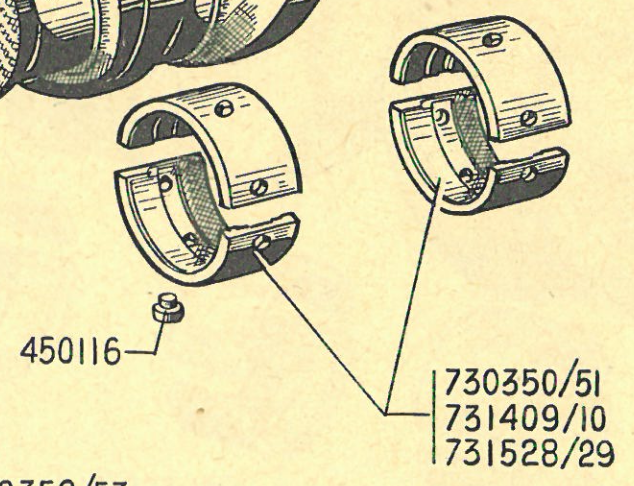
Even though a new numbering system appeared with the new post-war models 2CV, type H and all the good models that followed thereafter, these numbers continued to be used for many years (mostly for generic standard parts) until they were finally replaced by longer numbers in the age of electronic data processing, which for started for Citroën around 1969/70.
|
|

When Citroën was to re-start after the war, they also re-designed the spare part numbering system completely. As we see from this small excerpt of the 2CV catalogue 446 from 1952, this way of numbering parts started with the type H and was subsequently used for all almost all new models until just before 1970.
It is not, however, always that lateral versions are differentiated by a letter. In some instances, the parts simply have different numbers and if the numbers are consecutive, it is the main rule, that the left part holds the lowest number. The glass over the headlights on a D-model (Cibié 1967-75) is for instance named DX 541 24 for the left side and DX 541 25 for the right side.
It can be quite important to be accurate with these numbers: AM 453 3 A is a bracket, whereas AM 453 03 A is a main brake cylinder. I have not seen confusions of this kind in material from Citroën (but now and then among the audience), and the only source of confusion in this respect seems to be a lack of standard practice for the alphabetization of 0 respectively lack of 0. Hence, always look a bit up and down a page before concluding that a particular part is not there.
In the guide to the usage of the numbering system (for instance two whole pages in the 2CV catalogue from 1952, no. 446), Citroën writes that it is very important to remember to quote all letters and not just the number, as one otherwise might receive a completely different part than intended. It is very true and seems to us like a no-brainer, but we have to view this in the context that until then, the spare parts references had almost exclusively consisted of numbers.
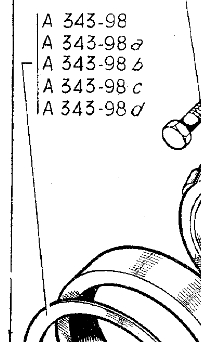

Once a part has got its number, it can easily be deployed elsewhere. A few examples: The light switch in a 2CV has the number HY 522 01B, and it is therefore a fair guess that this part first saw the light of day in an HY, before also being used in 2CV. The rubber handle AZ 644 79 on the ventilation knob on a 2CV has a number corresponding nicely with model and its function in group 6, but when the same knob is re-used in group 5 for the headlight height adjustment, it still retains the name AZ 644 79.
In the spare parts catalogues containing mainly this type of spare parts numbers (plus, of course, generic standard parts), there is no separate index in the french catalogues, since the parts are already more or less in numerical order according to their organ group. Already in the middle of the '60s other number series appear and an index is added to the catalogues - to begin with, however, without the generic standard parts, which are not included in the index before the late '70s.
In all the english catalogues, the dilligent people in the office in Slough used the extra resources necessary to equip the catalogues with a numerical index of all parts.
|
The model codes used in the spare parts numbers are not exactly the same
as the vehicle group codes, which
were later used in the spare parts number prefixes after 1970.
Therefore, they deserve their own table, placed here to the right.
The format of this type of spare part references in the period 1948-68 can
consequently be summarized like this:
From 1969 to 1979, this was simplified by abolishing the dash and purely using
capital letters:
Just around 1970-71 there was a short intermezzo where some numbers got
converted to the more IT-compatible format with the
extra digit "9",
which is explained later in this article:
Efter this short period, the previous format was resumed (only capital
letters and without dash). This then continued until around 1980 (possibly
starting in 1979), where a prefix with a two-letter vehicle group code was
added also to these numbers. Hence, they had this format in price lists,
catalogues etc:
|
| ||||||||||||||||||||||||||||||||||||||||||||||||||||||||||||||||||||||||||||||||||||||||||||||||||||||||||||||||||||||||||||||||||||||
|
The organ under-group numbers consist of three digits, the first of which is the
spare parts group number 1-9 according to the old classification 1948-70.
The next two digits are used to denote what more specific part of the vehicle the part belongs to.
These numbers are also used in repair manuals and as picture references in the spare parts catalogues
far into this century. They can be seen in the table to the right.
These under-group numbers are one of the most stable aspects of Citroën spare parts numbering. Even though many parts have changed main group over time, these under-group numbers remain unchanged. The exhaust system, for instance, belongs to main group 6 today, but picture numbers etc are still 182. In the catalogues of the more recent models (from around 1990) the picture numbers have four digits, but the fire three of these are still using this system. The first under-group number, that begin with 0 may appear as an anomaly, but there is actually also an explanation for that: In the first catalogues using this system (for instance the 2CV catalogue 446 from 1952), it is explained that the under-group number does not always have to be 3 digits if whole organs are concerned. A complete motor, for instance could be named A 1-03 and on the next level a complete gearbox could be A 33-0. As time went by, the under-group numbers of one and two digits were converted by adding zeroes in front. Later, for instance, a complete motor could have the number AM 001-021 A. |
| ||||||||||||||||||||||||||||||||||||||||||||||||||||||||||||||||||||||||||||||||||||||||||||||||||||||||||||||||||||||||||||||||||||||||||||||||||||||||||||||||||||||||||||||||||||||||||||||||||||||||||||||||||||||||||||||||||||||||||||||||||||||||||||||||||||||||||||||||||||||||||||||||||||||||||||||||||||||||||||||||||||||||||||||||||||||||||||||||||||||||||||||||||||||||||||||||||||||||||||||||||||||||||||||||||||||||||||||||||||||||||||||||||||||||||||||||||||||||||||||||||||||||||||||||||||||||||||||||||||||||||||||||||||||||||||||||||||||||||||||||||||||||||||||||||
|
Viewed at a glance, the spare part numbers for GS have the same general form as
the classical references: Model+under-group+sequence-number+letter,
but they are completely different from all other number series.
The under-group numbers in the GX series are only 2 digits and the classification is fundamentally different the traditional under-group numbers of 3 digits, which were used both before and after the very short period in history where the GX-numbers were assigned. They can be seen in the table to the right.
These, completely different under-group numbers are not the only thing setting the GX-numbers apart. The format is GX + 2-digit under-group number + 3-digit serial number + 2 digite which are often 01, but can be different + plus a letter which is normally A, but can be different.
There seems to be the system that the 3-digit serial number denotes different part, whereas
the 2-digit number denotes variants of the same part (colour, side etc, beginning with 01).
The letter (initially always A) can be updated to B, C etc, if a part is updated over time.
Here is a (rare) example of this usage of the letter, which otherwise is normally A or B:
Left/right is normally distinguished by the left side having a lower serial number (may both be the 3-digit or the 2-digit part) - never by changing letter A/B. Examples: Left/right indicator GX 60 166 01 A / GX 60 167 01 A where the difference is marked by changing the 3-digit part; Left/right sunscreen without mirror is GX 53 192 01 A / GX 53 912 02 A.
|
| ||||||||||||||||||||||||||||||||||||||||||||||||||||||||||||||||||||||||
It looks as though the GX number series have been used almost exclusively when the GS was designed, but very short thereafter (already from some time in 1971), no new numbers have been assigned using the GX series. When GS (and later GSA) should have new parts, the other number series were used - first the 5 000 000 series and later using the other series as they came into use.
At this point in time, when Citroën had created a whole new way of dividing the spare parts into organ groups for GS, you would normally think that this would then be applied to all aspects of documentation and schemes around this new car. This is not the case, however. Even in the very first repair manual, for instance, alle operations and chapters are divided according to the classical 3-digit under-groups. The GX number series and the 2-digits organ under-groups were just a parenthesis in history.
New spare parts for these vehicles (called les Utilitaires in French) got numbers that (naturally) started with U. At a first glance, you might think that this conforms to the system used for the ther spare parts numbers starting with a model code, but why this is not the case for the U numbers, is a complete mystery to me.
Although these numbers are usually written U 00 000, it is apparently the system that the first digit is group number according to the old system (1=motor, ... , 9=interior trim) and the next 4 digits are a serial number, which seems to be allocated sequentially from 0001, irrespective of what organ in the group or what model the part might belong to. It makes also no difference whether the part is produced by Citroën themselves, or by one of the many sub-suppliers.
A few examples: The first height corrector with LHM was named U 40 851 and its membrane U 40 848. When you encounter this in a D-model catalogue, you may find it odd that it has a "U" number. Well - this is very much in line with the Citroën tradition of testing new inventions with a smaller audience first, as these parts actually first appeared, not in the D-model, but the year before in a Type 60 bus with hydropneumatic suspension. U 50 338 is a brush holder for the plus side of a Ducellier dynamo, U 50 339 is the corresponding part the for minus side, U 40 732 is a steering column bearing for Belphégor (but re-use from T23). U 80 305 is a door lock cylinder for T23. U 90 038 is a front seat for an FOM, probably hard and uncomfortable in steel tubes and plywood.
| DK 00 000 | Used by Citroën Denmarkfor articles that the mother company did not know about. These numbers are observed from some time in the '80s to the present. There seems to be a kind of system where the first digit is some kind of of group number, and the rest is a serial number. It is, however, certainly not any of Citroën's standard number schemes they have used. It must be completely home-brew made by the people at the Danish daughter-company in Bådehavnsgade in Copenhagen. | ||
|---|---|---|---|
| KX 00000 | |||
| PL 000 000 | In order to separate the 6-digit spare part numbers used by Panhard from all all other numbers, PL (derived from Panhard-Levassor) was put in from of the numbers which was otherwise an original Panhard number. These numbers were still in the price lists in the 1980s. | ||
| ZA 00..0 000 L |
Autobianchi/Fiat spare parts. Around 1969, Citroën France started selling
Autobianchi cars, which had spare part numbers in common with Fiat. Fiat used
5-8 digits for their spare parts references which must obviously have posed
a conflict with some exiting Citroën numbers. This was solved by
"importing" the numbers into the Citroën catalogues by prefixing them
with the letters ZA.
The next time Citroën needed to import Fiat spare parts into their programme was for C35 (where many parts originate from Fiat 242), and furthermore for a few other parts, among others some parts for the GS Birotor gear box. Whereas ZF was later on used for importing all part numbers from Fiat, it looks as though Citroën continued to use ZA to begin with for all non-generic parts, even though it had nothing to do with Autobianchi anymore. The interior door handle on a C35 is for instance called 4118265 by Fiat and appears correspondingly as ZA 4118 265 L in the Citroën catalogues. For Autobianchi there are only suffix letters on a few part numbers for denoting variations of the same part (such as colour). The C35 parts, however, seem to be imported at the time when all numbers that did not already have a suffix letter where given the suffix L, just as it is mentioned in the section about The extra digit "9". | ||
| ZB 9000 000 A | Parts whose numbers are originally assigned by Berliet, but incorporated into the Citroën catalogues. For instance: The hydraulics pump in a C350K has the Berliet number 149 869, which is then translated to ZB 9149 869. There are sometimes a letter appended to the number (usually A), but the meaning of this is not clear to me. | ||
| ZF 00000 000 |
The ZF series is used to import spare part numbers from Fiat into the
catalogue of Citroën. In the '70s the numbers had the suffix letter L
and was almost exclusively used for generic parts, as the ZA-series were
used for the model-specific Fiat parts. It looks like ZA and ZF played the same
role for the import of Fiat numbers into the catalogue of Citroën as
ZC and ZD did for importing the old Citroën number series into the
system of the new era efter 1970. The numbers were imported unchanged:
An M8x19 bolt which was called 17675401 by Fiat was imported in the
C35 catalogue as ZF 17 675 401 L.
In the '80s, the ZA series were no longer used for assigning new numbers and all Fiat parts (both specific and generic) were imported as ZF-numbers. When you encounter a part with a ZF number today, it is therefore usually for the C25. | ||
| 70 00 000 000 |
| ||
| Y 000 000 000 | In the years around 1990, quite a number of parts for C25 got numbers in this series, which probably also was an import series. One theory could be that this series was used for Fiat numbers. | ||
| 90 00 000 000 | Yet another series for import of spare parts numbers, used from the last half of the '80s and continuing to around the same time (around 1994) when the 6-digit Peugeot numbers started to show up in the Citroën catalogues. Many of these are definitely Peugeot numbers, directly imported. An example: A gearbox casing for a Peugeot 104 has the number 2206.64 in the Peugeot catalogue and the same casing can be found in the LNA catalogue as 94 02 206 640. Numbers have been observed starting with 91, 94 and 97. This series was used in parallel with the 78/79 series above. |
| 0000-S | Simple, generic standard parts such as bolts, nuts, washers, greasers etc. The number can be 3 or 4 digits. I imagine that these articles always had to be ordered in packages containing a number of pieces. This series is used right from the beginning in 1919, but is converted by the end of the 1960s the new series, especially ZD and 20 000 000. | ||
|---|---|---|---|
| 0000-S-30 | Parts like above, but in som kind of variation, like for instance a bolt with a pointed end in stead of a flat. Most frequently, -30 is added, but numbers with 10, 20, 40 and a few others are also observed. | ||
| 00.000 | Generic part that could be ordered one at a time. It is typically bearings, sealing bushes, special bolts etc. These numbers are converted at the end of the 1960s to the new number series, especially the ZC series. | ||
| 000.000 | Some generic parts retained their pre-war numbers all the way until the end of the 1960s, where these numbers were converted to the new series - typically the ZC series. | ||
| ZC 9000 000 U | Replaces from around 1970 the numbers of the type 00.000 and 000.000. This series is both used for generic parts sold one at a time and for a range of various parts that clearly belong to a specific model, but had a past as a 6-digit pre-war number. For instance: 602.009 was converted to ZC 9 602 009 U. | ||
| ZD 9000 000 U |
| ||
| 20 000 000 |
|
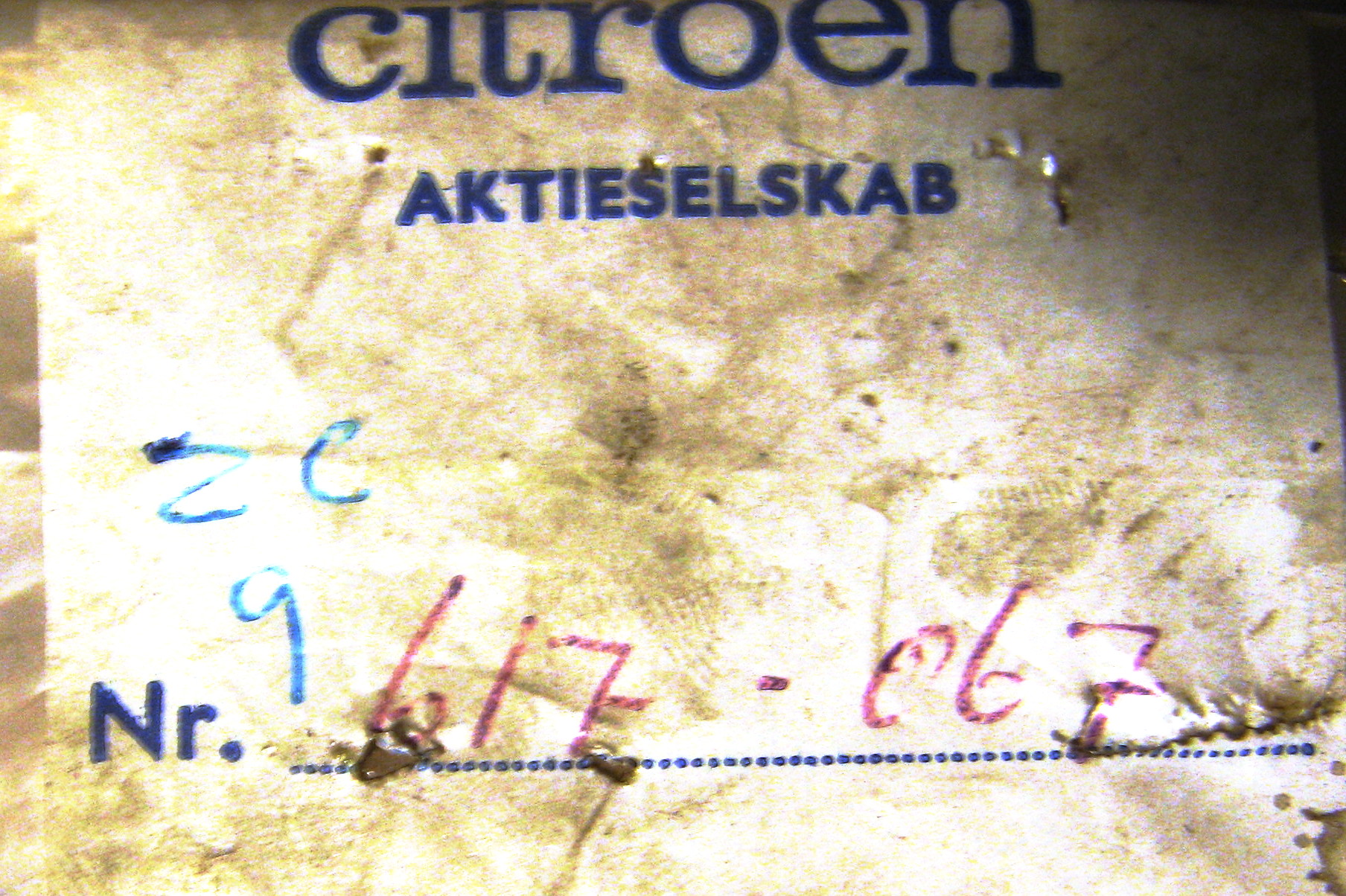
If you are searching for a particular part in catalogues or price lists, it may often be a good idea to see if the part can be found as a converted number in one of the other series, with the same digits. However, this is far from a safe method, as the subsequent conversions in many cases have been used to assign a completely new number to a particular part - also when the part itself has not changed at all.
|
It is a fair guess that this conversion transformed all spare parts number into the same format at this point in time:
Prefix + 7 digits + one letter, where the prefix could be either the model code (A, AM, AMN, AY, D, H, GX etc) or ZC/ZD or organ group + vehicle group letter.
The letter in the end was the suffix letter that the number had in the first place and if none existed, an L was added. If the number was the in the ZC/ZD series, it
already had U in this place, and if it was a number in the 5 000 000 series, the check letter was used.
As you can see from the example to the right (from the same catalogue), this had the beautiful consequence that all known spare parts number could fit in the same format, which was probably a demand for processing those in computers. This was the era of punched cards, where speedy processing of longs lists, ordered by column numbers was the order of the day. Why use exactly the number "9" in this place - why not some other number? The probable explanation for this could be that Citroën might have believed that all future spare parts numbers would have the same format as the newest number series at that time: The GX series. In a GX series number, the first digit after "GX" can be 0-8, but never 9. Therefore, the number "9" could be reserved for numbers in other systems. Whether this is more than just that - a theory - remains to be discovered, but it would also explain why, for instance, a standard indicator 12V/21W light bulb was converted from 706-750 to exactly ZC 9706 750 U be adding an extra "9". There are, by the way, also a very few examples of numbers with an extra "8" added. For instance, a clutch for an HY after 1968 is named HY 8312 000 B. Where this comes from, there could be many theories about, but not clear picture appears as yet. Observations/theories from you would be welcomed! At this point in time just around 1970, there were, for the first and only time at situation where (nearly) all parts numbers adhered to the same format: 2 or 3 characters + 7 digits + suffix letter. If you also regard the ZA, ZB and ZF references with a different number of digits as being consistent with this format, this unified system continued until the introduction of the Peugeot parts in the 78/79 series introduced with LN in 1976. |
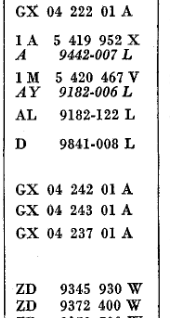
|
| Most of the numbers in the series beginning with model codes (A, AZ, AM, D, H, etc) continued after this brief period with their original numbers, but the few numbers that got to be converted, actually retained their new numbers with the extra digit "9". This is the reason why you may find a few numbers of this type, even in relatively recent catalogues. In the 2CV catalogue MIC01117 from 1991, for instance, you can find a ring for a Ducellier starter, which has the number DV 9533 267 A and a spring on the heater flap with the number AY 9 182 230 A. |
|
Probably, Citroën has come to the conclusion, that if the standard way of processing spare parts numbers were going to be computerized anyhow, it would not make any difference if they chose simple sequential numbers. If this was the reasoning behind these new sequential numbers, Citroën themselves, in my opinion, demonstrate that this was a false assumption since they needed to add the check letter, after this system had been in use for a number of months.
The number series 5 000 000 starts slowly somewhere between 07/70 and 01/71, and with this series, Citroën also starts (after a few months) to add spare parts group number and vehicle group code in front of the number and the check letter after the number. At the same time, Citroën writes that parts should be ordered by quoting both the spare part number itself ans the control letter. This has obviously served to minimize errors and mix-ups. This practice, however, appears to have been dropped some time before 1980, where it is stated in the catalogs that you should only quote the number itself in orders.
| 5 000 000 |
Assigned from around 1971 to 1976
| ||
|---|---|---|---|
| 75 000 000 | Assigned 1976-79 
| ||
| 90 000 000 | These numbers are assigned 1980-94.
| ||
| 0000.00 |
|
The format for the 5 000 000 series (and the series 20 000 000 and 75 000 000) looked
1971-79 like this:
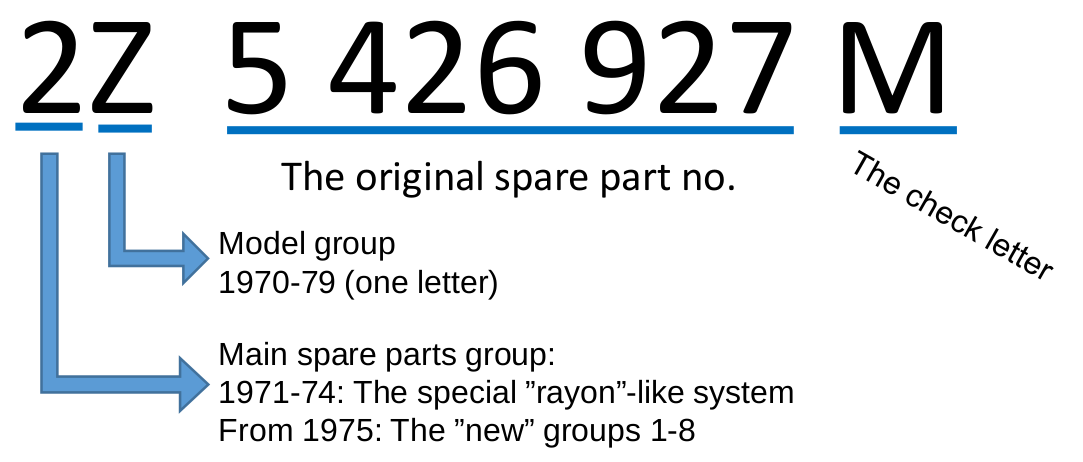
From 1980 the check letter was dropped and the two-letter
vehicle group codes were introduced:
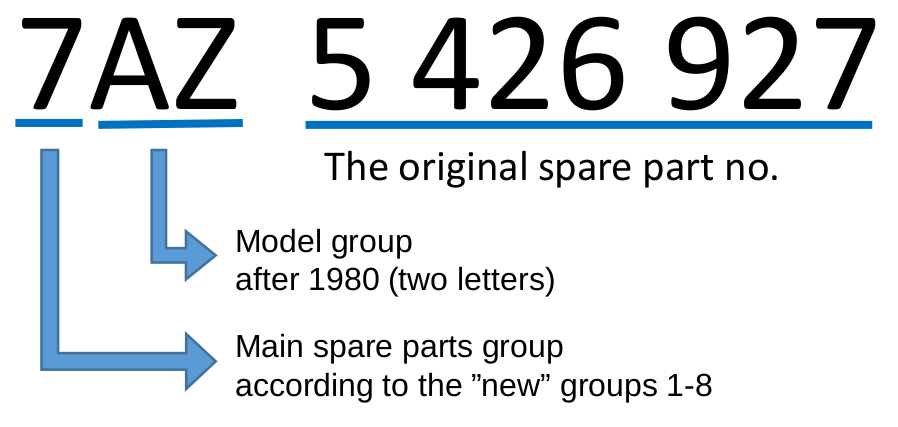
In these number series, it was also possible to take the next available number or letter, when an extra colour was invented for specific part. When Citroën changed to sequential numbers (the 5 000 000 series etc) this was not possible anymore, and furthermore it grew much more common with many colour variants for the same part.
Therefore, Citroën started adding colour codes to the spare part number, separated by an asterisk. Thus, a red dashboard for a Méhari from 1975 has the number 5 459 117*201, whereas the similar green version is named 5 459 117*405.
This method, though, was not used in all cases at the beginning of the new number series, but grew to be more and more used during the first half of the 1970s. The bonnets for Méhari was in 1971 named 5 405 366, -367, -368 and -369 in the colours red, green, ocre and orange.
| On packages and labels and in some other contexts, Citroën used a slash instead of an asterisk to separate the two parts of the number. Some kind of separation was of course necessary in order to make sure that the combined number was not mistaken for a very long spare part number. |

|
| In the last half of the 1980s, colour codes changed from three digits to two or three letters. This meant that there was no further need for separation between spare part number and colour code. A blue switch for the rear wiper on a BX is for instance named 95 634 829 FLE. In this case, there is no asterisk or slash to separate the number itself from the colour code FLE, but on the other hand, there is no doubt possible as to what is the spare part number and what is the colour code. |

|
| This practice of no separator also found its way back into the numbers with 3-digit colour codes, which sometimes appear without asterisk or slash - as one long combined number. In a few instances, this can lead to confusion and mistakes, but this is not a big problem. The real problem with these combined numbers is the how they are sorted and placed in the index of a catalogue or in a price list. Parts with colour codes can actually be quite challenging to find sometimes. |

|
| Originally, it was the intention that parts numbers with colour codes should be sorted in indices and other lists alongside the original spare part number. An example of this (originally intended) practice can be seen in the CX catalogue MIC 01192 from 1981: |

|

It runs totally amuck when if want, for instance,
to find all parts in the (Danish) price list around 95 567 646.
They exist in three different places:
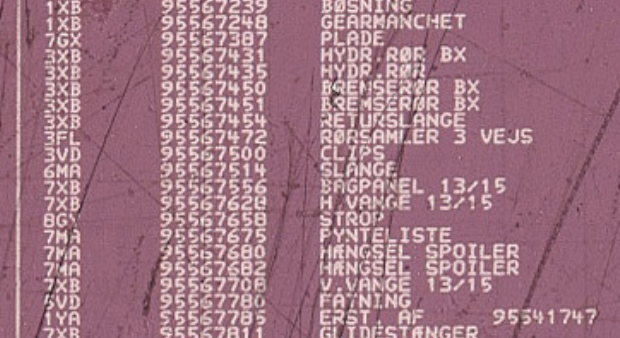
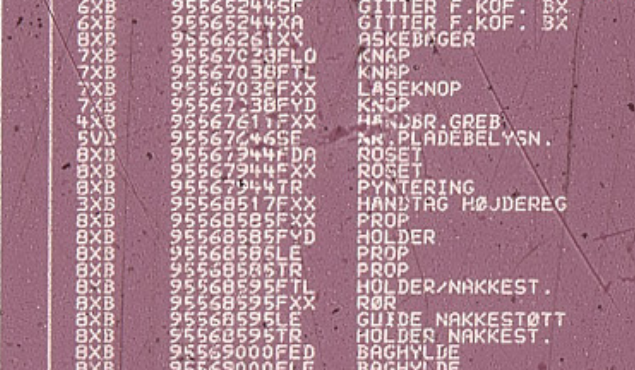
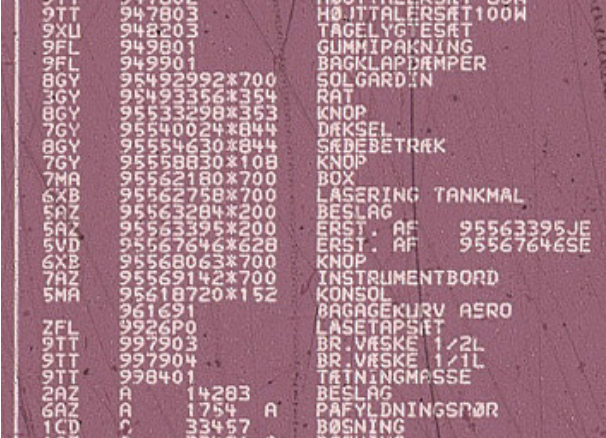
Colour codes in this system are observed in connection with numbers series 5 000 000, 75 000 000 and 95 000 000, but not in combination with the series 78/79 and the Peugeot series 0000.00.
Special numbers for LHMAt the time when LHM was introduced in 1965, most spare part numbers were of the classical form beginning with a model code of 1-3 letters. When an LHM version of a part was introduced, it was usually assigned the same number, but the model code was exchanged with a new code ending with the letter N. In the example here, the rubber cap for a brake valve for ID for red fluid has the number DM 453 36, while the new version for LHM is called DVN 453 36. This also applies when LHM supersedes traditional brake flud: for instance is a complete Ami8 rear axle named AM 42-0 G and after 9/69 when it is converted to LHM, the number becomes AMN 42-0.When the model code ends with an N, it is a sure sign that this part is for LHM. This was also the case for new parts which didn't have a counterpart for red fluid, and even for models that had never existed with other fluids than LHM (SM, M35 and Belphégor). On the other hand, it is worth to note that many parts for LHM have other types of numbers than those with a model code ending in N, notably those with numbers of 4-6 digits used for seals and standard parts (which was converted later into the ZC/ZD series) as well as the spare parts beginning with U. The allocation of special numbers for LHM parts disappeared again when the classical number system (numbers beginning with model code) went out of use by 1970. Since then, LHM parts have been assigned numbers in the current number series of the day (such as 5 000 000), like any other parts. To help avoid mistakes, once LHM was introduced in 1965, Citroën began using red spare part labels for red fluid and green for LHM. This went out of use again some time in the 1980's, but there is still a tradition that the parts themselves - especially seals for LHM - bear some kind of green marking. | 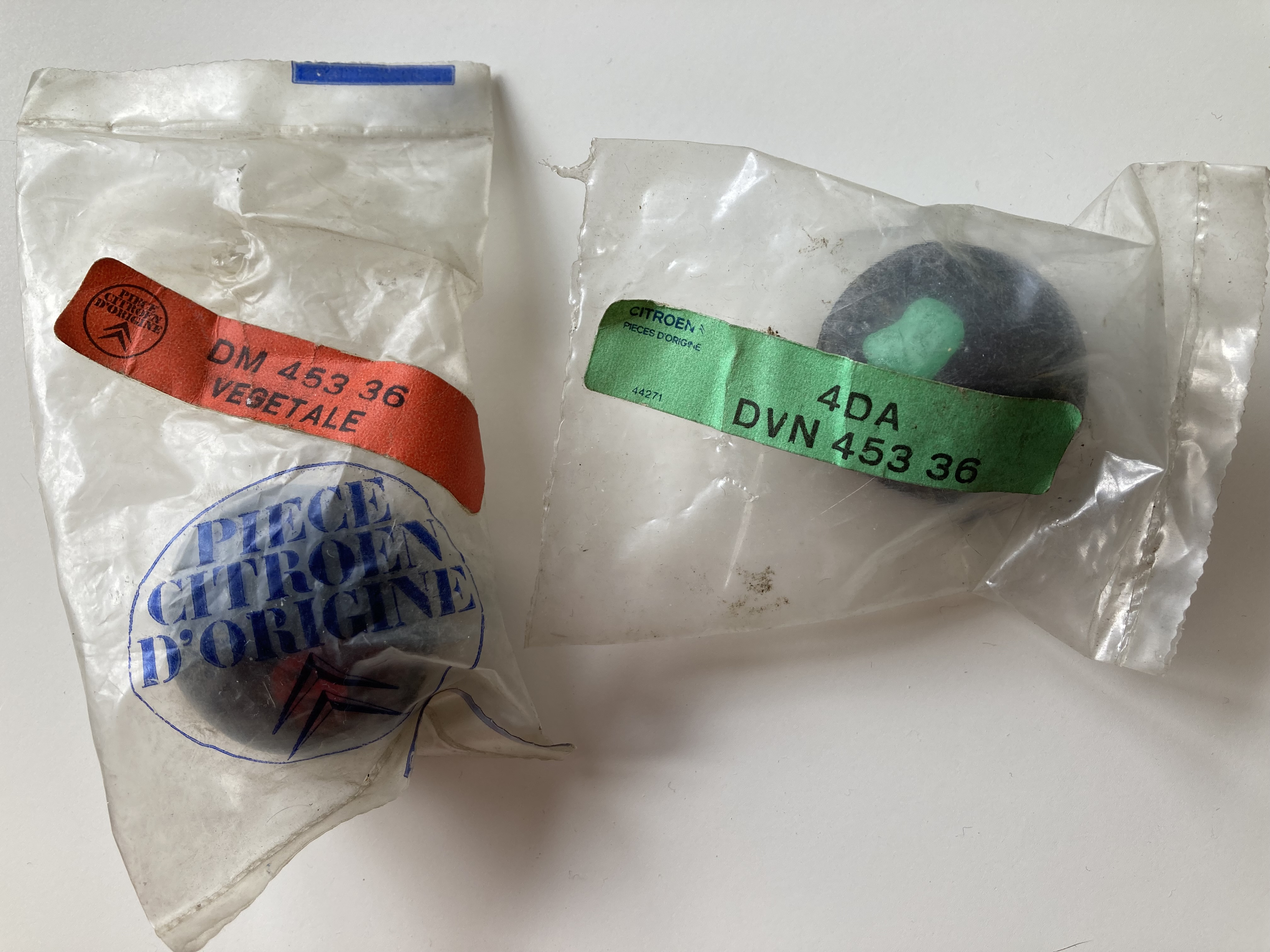
|
|
One especially nerdy subject is the check letter, which is appended to spare parts numbers in the series 5 000 000, 20 000 000 and 75 000 0000. It appears in
spare parts catalogues and on the labels of the parts.
In the very first catalogues (ie. no. 596 from 01/71) containing these number series, these numbers are written without model prefix and without this check letter appended, but in the catalogues after this and onwards until these numbers are no longer assigned, they are usually written with both prefix and with the check letter. Apparently, there has been a greater chance to introduce an error when such a number was written by hand, on typewriter og for a typesetter than for the previous number series. Furthermore, if a digit was wrong, there were no sure way of detecting this since this wrong number would probably also be a valid spare part number, due to the fact that these numbers were generally assigned sequentially. Hence the need for a check letter to enable detection of such errors. |
|
If you have a spare part number of this kind, you find the check letter by multiplying the spare part number by 10 and divide it by 23. The remainder (0-22) that results from this division corresponds to the letters ABCDEFGHJKLMNPRSTUVWXYZ, where A corresponds to 0, B to 1 etc. You notice that the letters most easily mistaken for digits (I, O and Q) are omitted from the check letters.
Division of a number of 8 or 9 digits by 23 is not an operation which is easily performed by hand, as you need all the digits to find the remainder. Even on a classical pocket or desk calculator with 8 digits, this operation can be problematic. The purpose of this check letter must therefore have been to identify errors in spare parts numbers when entered into a computer. You can try yourself to find the check letter for a spare part number using whis website.
The actual need for this kind of control, is demonstrated by Citroën themselves in qute a few places. In the index to volume I of the D-model catalogue 648, you find 5 404 254 U. The correct check letter for 5 404 254 is found as described above by dividing 54042540 by 23. This gives a quotient of 2349675 and the remainder 5404254-2349675*23=15. When you count forwards to 15 in the sequence of check letters (remember that A is at place number 0), you reach the letter S. A correct spare part number would therefore have been 5 404 254 S, and something is wrong. The actual error in this case, is that the typesetter has exchanged two digits in the correct number 5 404 245 U, which you can also verify in the relevant page in the catalogue.
When you test the catalogues like this, you find that this fits most numbers and usually the few deviations can be traced back to printing errors of the kind above. But these errors also demonstrate that this kind of check was not carried out consistently. The system of check letters also dissappeared again, probably when Citroën stopped assigning new numbers in these series or maybe even shortly before that.
If the spare part number has an added color code, the check letter is found based on the original spare part number exclusively. All
colour variants of the same part therefore have the same check letter.

When you look at the newest spare parts catalogue for 2CV, you can still find numbers of this type. The front silencer, for instance, has the number 5 490 718, but there is no check letter. The check letter disappeared from catalogues, pricelists and all other contexts around 1980.

| 0000-T |
| ||
|---|---|---|---|
| ADD 0000000 | Addenda for repair manuals. Observed in the '90s. | ||
| AMC 0000000X | Promotional clothing. If there is a suffix letter, it seems to denote the size (S,M,L,X) | ||
| BRE 000 000 |
From the end of the 1980s and through the 1990s, Citroën
gradually changes the way in which the technical documentation is
organized and updated, going from whole manuals for a model (with
subsequent updates) to a collection of smaller individual documents,
each of which is
re-published or changed completely in case of updates.
These booklets (Brochures Réparation) are initially
numbered in the same sequence of 6 digits used for most other publications in
the 1980s, but in the first half of the 1990s the numbering re-starts
with a separate 4-digit number series.
Supplementary to the use as sections of repair manuals etc., there are a few examples that BRE-publication have also been used for catalogues of workshop articles. |
||
| CAR 000000 |
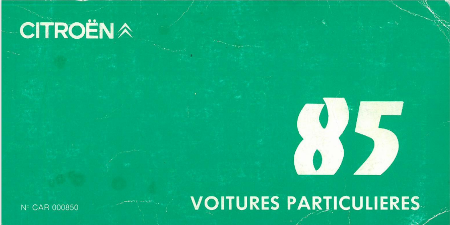 Booklets (carnets) containing technical data and brief technical information for workshops for all models.
They only appeared for a few years in the 1980s.
Booklets (carnets) containing technical data and brief technical information for workshops for all models.
They only appeared for a few years in the 1980s.
|
||
| CAT 000000 | Spare parts catalogues - exist both on paper and microfilm. If it is a price list, there is also an H appended to the number. | ||
| IMC 0000000 A | Service forms to fill in by workshops, advertising folders and other internal material | ||
| MAJ 0000 000 | Model specific documentation of some kind | ||
| MAN 000 000 | Spare parts catalogues and repair times booklets | ||
| MIC 000 000 | Microfilm spare parts catalogues. The number can have 5 or 6 digits. For catalogues after around 1990, the number has 5 digits and possibly a letter denoting the language (A=Anglais, D=Deutsch). | ||
| OUT 00 0000 T | Special tools (outillage). This series replaced in the late '70s the series 0000-T. Example: A set of tools for lifting a CX body was first sold as 6606-T and later as OUT 50 6606 T. | ||
| SRV 000 000 | Consumable materials for workshops, such as clamps, fuel filters, batteries etc. | ||
| TPS 000 000 | Repair times | ||
| ZCE 000 000 | Paint, sealing etc | ||
| ZCP 000 000 | Paint, sealing etc | ||
| ZCT 000 000 | Tools etc |